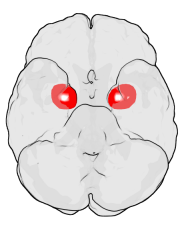
Photo from wikipedia
Despite the overlapping neural circuits underlying natural and drug rewards, several studies have suggested different behavioral and neurochemical mechanisms in response to drug vs. natural rewards. The strong link between… Click to show full abstract
Despite the overlapping neural circuits underlying natural and drug rewards, several studies have suggested different behavioral and neurochemical mechanisms in response to drug vs. natural rewards. The strong link between hippocampal theta oscillations (4–12 Hz) and reward-associated learning and memory has raised the hypothesis that this rhythm in hippocampal CA1 might be differently modulated by drug- and natural-conditioned place preference (CPP). Time–frequency analysis of recorded local field potentials (LFPs) from the CA1 of freely moving male rats previously exposed to a natural (in this case, food), drug (in this case, morphine), or saline (control) reward cue in the CPP paradigm showed that the hippocampal CA1 theta activity represents a different pattern for entrance to the rewarded compared to unrewarded compartment during the post-test session of morphine- and natural-CPP. Comparing LFP activity in the CA1 between the saline and morphine/natural groups showed that the maximum theta power occurred before entering the unrewarded compartment and after the entrance to the rewarded compartment in morphine and natural groups, respectively. In conclusion, our findings suggest that drug and natural rewards could differently affect the theta dynamic in the hippocampal CA1 region during reward-associated learning and contextual cueing in the CPP paradigm.
Journal Title: Brain Sciences
Year Published: 2023
Link to full text (if available)
Share on Social Media: Sign Up to like & get
recommendations!